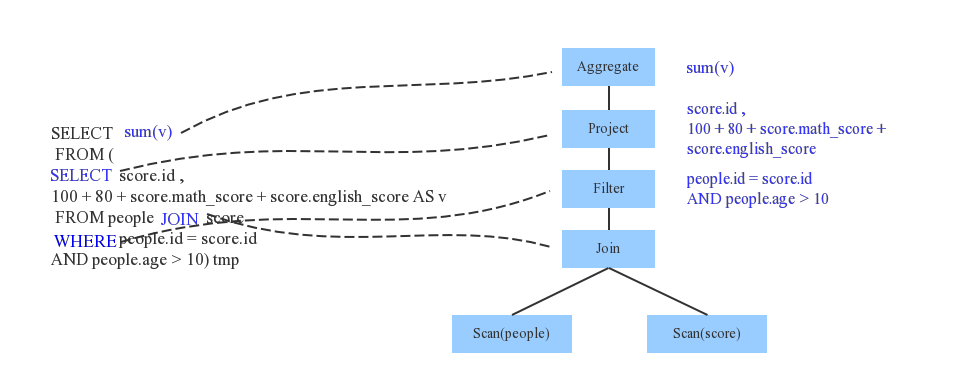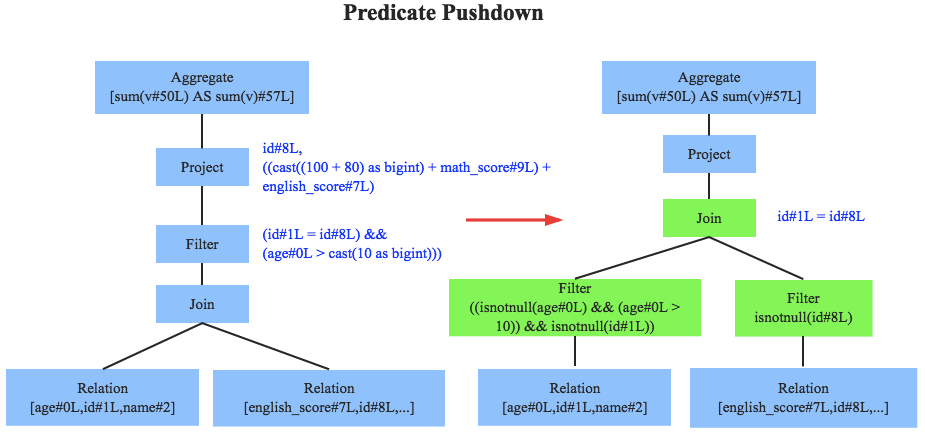目录
Background
从源码层面解释一个sparkSql语句是如何执行的,从sql到与底层RDD如何对接
Spark Sql概述##
spark sql是 apache spark的其中一个模块,主要用于进行结构化数据的处理。spark sql的底层执行还是调用rdd,在之前的文章中提过rdd的执行流程,因此本文主要讲解一下从sql到底层rdd的对接。通过观察spark sql 模块的源码,源码分为四个部分,如下图。

在官方github的sql模块readme文件有如下描述。
-
Catalyst (sql/catalyst) - An implementation-agnostic framework for manipulating trees of relational operators and expressions.
-
Execution (sql/core) - A query planner / execution engine for translating Catalyst’s logical query plans into Spark RDDs. This component also includes a new public interface, SQLContext, that allows users to execute SQL or LINQ statements against existing RDDs and Parquet files.
-
Hive Support (sql/hive) - Includes an extension of SQLContext called HiveContext that allows users to write queries using a subset of HiveQL and access data from a Hive Metastore using Hive SerDes. There are also wrappers that allow users to run queries that include Hive UDFs, UDAFs, and UDTFs.
-
HiveServer and CLI support (sql/hive-thriftserver) - Includes support for the SQL CLI (bin/spark-sql) and a HiveServer2 (for JDBC/ODBC) compatible server.
本文主要讲解core和catalyst模块。首先给一个spark sql语句执行流程,来方便对后续内容进行整体把握。
- SQL 语句经过 SqlParser 解析成 Unresolved LogicalPlan;
- 使用 analyzer 结合数据数据字典 (catalog) 进行绑定, 生成 resolved LogicalPlan;
- 使用 optimizer 对 resolved LogicalPlan 进行优化, 生成 optimized LogicalPlan;
- 使用 SparkPlan 将 LogicalPlan 转换成 PhysicalPlan;
- 使用 prepareForExecution() 将 PhysicalPlan 转换成可执行物理计划;
- 使用 execute() 执行可执行物理计划;
- 生成 RDD。
源码跟踪
首先是要创建sparkSession然后导入数据,此处不赘述。我们从执行sql语句开始跟踪。
val teenagersDF = spark.sql("SELECT SUM(v) FROM (SELECT score.id, 100+80+ score.math_score +score.english_score AS v FROM people JOIN score WHERE people.id=score.id AND people.age >100) tmp")
sql 语句-> Unresolved LogicalPlan###
此部分主要是对sql语句进行解析。判断一条sql语句是否符合要求,并且进行各部分的划分,比如哪些是操作,哪些是得到的结果等等。

这样一句sql 调用,跟进去。
def sql(sqlText: String): DataFrame = {
Dataset.ofRows(self, sessionState.sqlParser.parsePlan(sqlText))
}
我们可以看到sql语句会返回一个dataFrame。而在spark中DataFrame的定义就是Dataset[Row] .值得一提的是,在spark源码中用到了许多lazy变量,这些变量虽然是声明在类中,但是并不是在创建对象的时候就初始化这些变量,而是在第一次调用是才进行初始化,因此在跟踪源码时一定要注意这些lazy变量的调用,因为很多lazy变量的初始化都涉及到一系列函数的调用。如果不注意,会失去对很多函数的跟踪。具体lazy变量的介绍,可以参考.
lazy val sqlParser: ParserInterface = new SparkSqlParser(conf)
可以看到sqlParser就是一个lazy变量,它会创建一个解析器。上述的sql函数在创建解析器之后调用parsePlan函数,如下。
/** Creates LogicalPlan for a given SQL string. */
override def parsePlan(sqlText: String): LogicalPlan = parse(sqlText) { parser =>
astBuilder.visitSingleStatement(parser.singleStatement()) match {
case plan: LogicalPlan => plan
case _ =>
val position = Origin(None, None)
throw new ParseException(Option(sqlText), "Unsupported SQL statement", position, position)
}
}
这个函数是使用了Scala柯里化特性。其实是调用的parse函数。
protected def parse[T](command: String)(toResult: SqlBaseParser => T): T = {
logInfo(s"Parsing command: $command")
val lexer = new SqlBaseLexer(new ANTLRNoCaseStringStream(command))
lexer.removeErrorListeners()
lexer.addErrorListener(ParseErrorListener)
val tokenStream = new CommonTokenStream(lexer)
val parser = new SqlBaseParser(tokenStream)
parser.addParseListener(PostProcessor)
parser.removeErrorListeners()
parser.addErrorListener(ParseErrorListener)
try {
try {
// first, try parsing with potentially faster SLL mode
parser.getInterpreter.setPredictionMode(PredictionMode.SLL)
toResult(parser)
}
catch {
...
}
}
catch {
...
}
}
}
而此处的parse函数是使用的Antlr(一个开源语法分析器)来对sql语句进行解析,lexer是其词法分析器,然后spark使用自身的sqlBaseParser对sql语句进行语法分析,结合parse和parsePlan函数,得到了sql语句的UnresolvedLogicalPlan.
Resolved LogicalPlan###
此部分是对之前得到的逻辑计划进行分析,比如这个字段到底应该是什么类型,等等,不是很熟悉编译。

进入到Dataset类的ofRows函数。
def ofRows(sparkSession: SparkSession, logicalPlan: LogicalPlan): DataFrame = {
val qe = sparkSession.sessionState.executePlan(logicalPlan)
qe.assertAnalyzed()
new Dataset[Row](sparkSession, qe, RowEncoder(qe.analyzed.schema))
}
这个函数很短,跟踪executePlan函数,可以看到它是创建了一个queryExecution对象。
def executePlan(plan: LogicalPlan): QueryExecution = new QueryExecution(sparkSession, plan)
这个对象是很重要的一个对象,涉及到前面的UnresolvedLogicalPlan的分析、优化、转物理计划以及ToRDD所有操作。
ofRows函数第二行是对逻辑计划进行确认分析,里面涉及到分析操作,分析是对之前逻辑计划里面的属性进行分析。分析的源码我就不贴了,分析是使用一套既定的规则,然后进行多次迭代,知道分析结果达到一个固定点或者到达最高迭代次数停止。得到resolvedLogicalPlan.
OptimizedLogicalPlan###
此部分主要是对逻辑计划进行优化, 例如谓词下推等等。

然后第三行,就是生成一个Dataset[Row],前面提到过,其实这就是dataFrame。
跟踪进入Dataset的this函数。里面有一个变量会在创建对象时执行
@transient private[sql] val logicalPlan: LogicalPlan = {
def hasSideEffects(plan: LogicalPlan): Boolean = plan match {
case _: Command |
_: InsertIntoTable => true
case _ => false
}
queryExecution.analyzed match {
// For various commands (like DDL) and queries with side effects, we force query execution
// to happen right away to let these side effects take place eagerly.
case p if hasSideEffects(p) =>
LogicalRDD(queryExecution.analyzed.output, queryExecution.toRdd)(sparkSession)
case Union(children) if children.forall(hasSideEffects) =>
LogicalRDD(queryExecution.analyzed.output, queryExecution.toRdd)(sparkSession)
case _ =>
queryExecution.analyzed
}
}
看到里面有一行调用了LogicalRDD函数,第一个参数是输出位置,第一个参数,queryExecution.toRdd. 一系列的lazy变量。
lazy val toRdd: RDD[InternalRow] = executedPlan.execute()
lazy val executedPlan: SparkPlan = prepareForExecution(sparkPlan)
lazy val sparkPlan: SparkPlan = {
SparkSession.setActiveSession(sparkSession)
// TODO: We use next(), i.e. take the first plan returned by the planner, here for now,
// but we will implement to choose the best plan.
planner.plan(ReturnAnswer(optimizedPlan)).next()
}
lazy val optimizedPlan: LogicalPlan = sparkSession.sessionState.optimizer.execute(withCachedData)
这里调用了一些列,调用到optimizedPlan,其实也是进行规则优化,基于一系列规则,到不动点或者最大迭代次数退出优化。这就得到了optimizedLogicalPlan.
PhysicalPlan###
回到前面的sparkPlan懒变量,最后一句,planner.plan对之前的 optimizedLogicalPlan进行转化生成phsicalPlan。此处的next是操作是获得返回的physicalPlan迭代器中的第一个physicalPlan。
lazy val sparkPlan: SparkPlan = {
SparkSession.setActiveSession(sparkSession)
// TODO: We use next(), i.e. take the first plan returned by the planner, here for now,
// but we will implement to choose the best plan.
planner.plan(ReturnAnswer(optimizedPlan)).next()
}
这里的planner为SparkPlanner,类中有一系列的策略,还可以从外部加策略。
def strategies: Seq[Strategy] =
extraStrategies ++ (
FileSourceStrategy ::
DataSourceStrategy ::
DDLStrategy ::
SpecialLimits ::
Aggregation ::
JoinSelection ::
InMemoryScans ::
BasicOperators :: Nil)
然后进行转化的函数如下。
def plan(plan: LogicalPlan): Iterator[PhysicalPlan] = {
// Obviously a lot to do here still...
// Collect physical plan candidates.
val candidates = strategies.iterator.flatMap(_(plan))
// The candidates may contain placeholders marked as [[planLater]],
// so try to replace them by their child plans.
val plans = candidates.flatMap { candidate =>
val placeholders = collectPlaceholders(candidate)
if (placeholders.isEmpty) {
// Take the candidate as is because it does not contain placeholders.
Iterator(candidate)
} else {
// Plan the logical plan marked as [[planLater]] and replace the placeholders.
placeholders.iterator.foldLeft(Iterator(candidate)) {
case (candidatesWithPlaceholders, (placeholder, logicalPlan)) =>
// Plan the logical plan for the placeholder.
val childPlans = this.plan(logicalPlan)
candidatesWithPlaceholders.flatMap { candidateWithPlaceholders =>
childPlans.map { childPlan =>
// Replace the placeholder by the child plan
candidateWithPlaceholders.transformUp {
case p if p == placeholder => childPlan
}
}
}
}
}
}
val pruned = prunePlans(plans)
assert(pruned.hasNext, s"No plan for $plan")
pruned
}
没看明白,知识欠缺。大概就是得到一系列physicalPlan,然后进行剪枝,筛除掉性能不好的,这就得到了physicalPlan迭代器,然后通过前面说的next函数,得到迭代器头部的physicalPlan,应该是最好的那个。
可执行的物理计划###
在得到物理计划sparkPlan之后会执行下面的函数,prepareForExecution(sparkPlan),得到可执行的物理计划。
lazy val executedPlan: SparkPlan = prepareForExecution(sparkPlan)
/**
* Prepares a planned [[SparkPlan]] for execution by inserting shuffle operations and internal
* row format conversions as needed.
*/
protected def prepareForExecution(plan: SparkPlan): SparkPlan = {
preparations.foldLeft(plan) { case (sp, rule) => rule.apply(sp) }
}
/** A sequence of rules that will be applied in order to the physical plan before execution. */
protected def preparations: Seq[Rule[SparkPlan]] = Seq(
python.ExtractPythonUDFs,
PlanSubqueries(sparkSession),
EnsureRequirements(sparkSession.sessionState.conf),
CollapseCodegenStages(sparkSession.sessionState.conf),
ReuseExchange(sparkSession.sessionState.conf),
ReuseSubquery(sparkSession.sessionState.conf))
看注释以及源码,理解,就是又是一些规则,然后对逻辑计划不断使用这些规则进行完善,就是把规则按顺序运用一遍,scala的 foldleft用法参考这里,不得不说scala语法真多。
执行
可以看到在获得获得可执行计划之后就是执行,
lazy val toRdd: RDD[InternalRow] = executedPlan.execute()
final def execute(): RDD[InternalRow] = executeQuery {
doExecute()
}
//class sparkPlan
protected def doExecute(): RDD[InternalRow]
这个函数对应很多子类,每个子类的第一句基本都是child.execute(),可见这是在构建lineage。也就是一条链,把所有可执行计划串联起来。
这里的doExecute返回的是一个中间类型的RDD。